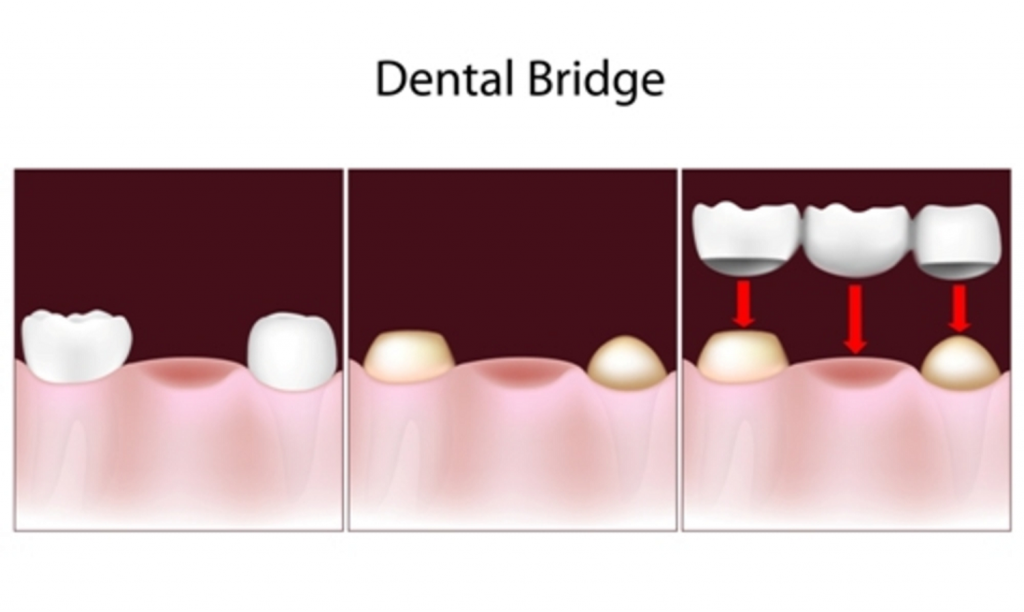After having a tooth extracted you will need to fill the gap left by the lost tooth to restore the normal functioning of your mouth. Dental bridges are a popular method, as they are more affordable than dental implants. This restorative procedure can be carried out by a dentist near you in just 2 visits and is a more permanent solution in comparison to dentures— bridging the gap from an extracted tooth.
What are dental bridges?
A dental bridge consists of two parts which are:
Two crowns – These are hollow artificial teeth that are placed over the real teeth on either side of the gap to form support.
Pontic – A pontic is an artificial tooth or the prosthesis that is placed between the crowns to fill the gap left by a missing tooth.
What is the procedure for dental bridges?
This restorative procedure is usually completed within 2 visits to a dental clinic providing services for dental bridges near you.
First visit – Your dentist will examine the site of tooth extraction to ensure it has healed and is ready to be worked upon. Then the teeth on either side of the gap, that will act as pillars supporting the bridge, will be filed down to make room for the crowns. The dentist will then make impressions of your teeth to form molds for the customized dental bridges. The two crowns and the pontic will be made as one piece which is called a dental bridge. Once these procedures are complete, a temporary bridge is fixed in your mouth until the next visit.
Usually, your teeth impressions are sent to a laboratory to build your customized dental bridge but sometimes a dentist in Mahogany might choose to use the CEREC technology that creates dental crowns instantly. In that case, a second visit will not be necessary.
Second and final visit – It usually takes about 2 weeks for the laboratory to prepare a dental bridge. When your customized fixed dental bridges are ready and sent to your dentist, you will be asked to visit for the final procedure. At this visit, the temporary bridge is removed and the site is sanitized thoroughly before the permanent dental bridge is placed in your mouth.
Once the procedure is over, you can go about your day as you normally would, with the same oral hygiene practices that you performed before getting a dental bridge. Brushing your teeth, flossing, and using mouthwash are enough to make your dental bridge last up to 15 years!
Types of dental bridges
There are several types of dental bridges available to choose from, depending upon the type of support needed and the position of the missing tooth or teeth.
-
Traditional bridges – These dental bridges are the most common ones that utilize healthy teeth on either side of the missing tooth to act as supports. They consist of two crowns placed over natural teeth, and a prosthesis or pontic that fills the gap left by a missing tooth.
-
Maryland bridges – This kind of dental bridge does not require filing down of the healthy teeth on either side of the dental gap. Instead, it uses a metal or porcelain framework over the adjacent natural teeth to support the prosthesis tooth.
-
Cantilever bridges – When the dental bridge is supported only on one side by a natural tooth, it is termed as cantilever bridge. While the benefit of this method is less damage to healthy teeth, the downside is that it puts a lot of pressure on a single tooth making it vulnerable to fracture.
-
CEREC bridges – This type of dental bridge is created in the office of dentists in just one visit. It uses the CEREC technology to create same-day crowns that match your natural teeth perfectly.
What are dental bridges made out of?
The most common materials being used to prepare dental bridges are:
- Porcelain
- Metal
- Porcelain with a metal base
Choosing between the different types of dental bridges and their materials can be a daunting task but an experienced dentist providing services for dental bridges in Mahogany can make this process easier for you.

